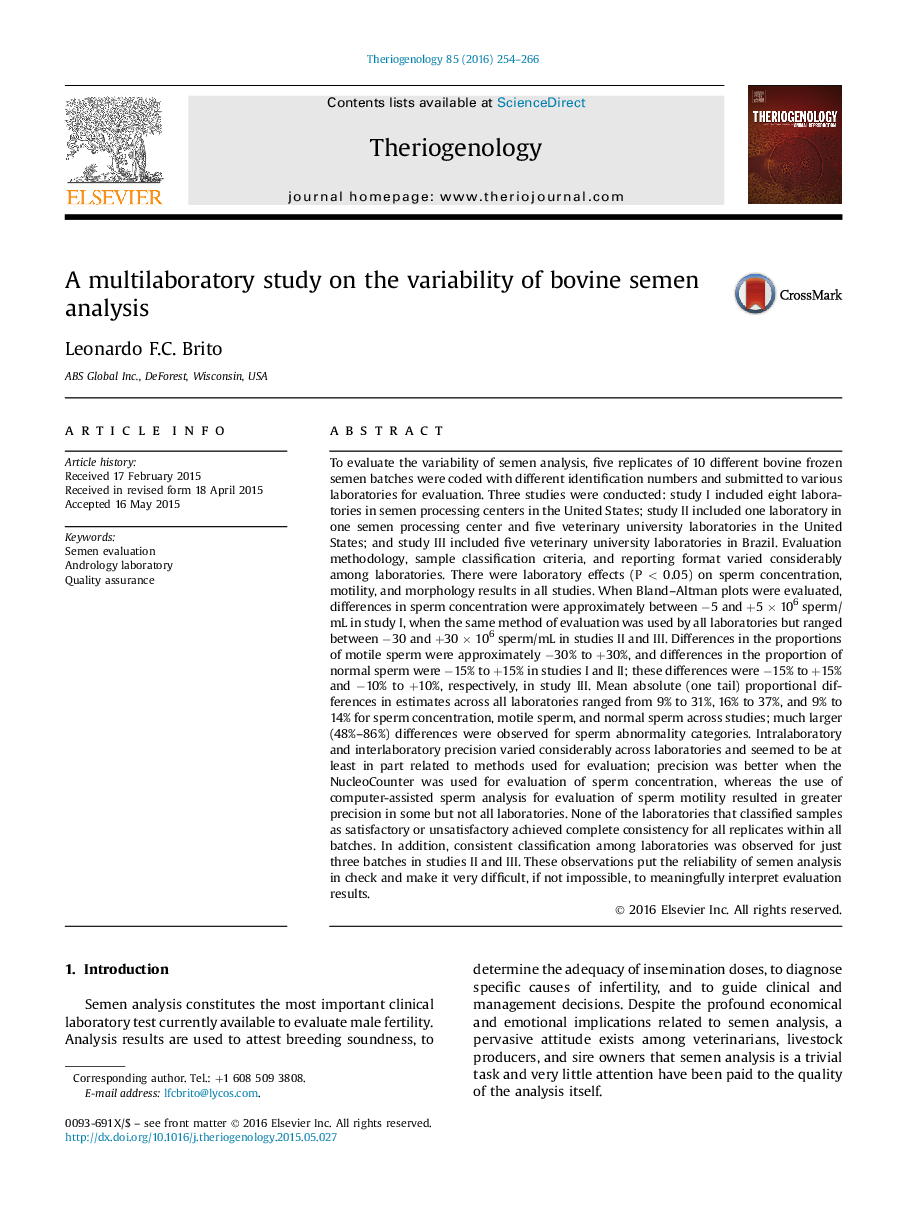| کد مقاله | کد نشریه | سال انتشار | مقاله انگلیسی | نسخه تمام متن |
|---|---|---|---|---|
| 2094845 | 1082055 | 2016 | 13 صفحه PDF | دانلود رایگان |
عنوان انگلیسی مقاله ISI
A multilaboratory study on the variability of bovine semen analysis
ترجمه فارسی عنوان
یک مطالعه چندمعیبی در مورد تغییرپذیری تجزیه و تحلیل اسپرم گاو
دانلود مقاله + سفارش ترجمه
دانلود مقاله ISI انگلیسی
رایگان برای ایرانیان
کلمات کلیدی
ارزیابی اسپرم، آزمایشگاه آندرولوژی، تضمین کیفیت،
موضوعات مرتبط
علوم زیستی و بیوفناوری
علوم کشاورزی و بیولوژیک
علوم دامی و جانورشناسی
چکیده انگلیسی
To evaluate the variability of semen analysis, five replicates of 10 different bovine frozen semen batches were coded with different identification numbers and submitted to various laboratories for evaluation. Three studies were conducted: study I included eight laboratories in semen processing centers in the United States; study II included one laboratory in one semen processing center and five veterinary university laboratories in the United States; and study III included five veterinary university laboratories in Brazil. Evaluation methodology, sample classification criteria, and reporting format varied considerably among laboratories. There were laboratory effects (PÂ <Â 0.05) on sperm concentration, motility, and morphology results in all studies. When Bland-Altman plots were evaluated, differences in sperm concentration were approximately between â5 and +5Â ÃÂ 106 sperm/mL in study I, when the same method of evaluation was used by all laboratories but ranged between â30 and +30Â ÃÂ 106 sperm/mL in studies II and III. Differences in the proportions of motile sperm were approximately â30% to +30%, and differences in the proportion of normal sperm were â15% to +15% in studies I and II; these differences were â15% to +15% and â10% to +10%, respectively, in study III. Mean absolute (one tail) proportional differences in estimates across all laboratories ranged from 9% to 31%, 16% to 37%, and 9% to 14% for sperm concentration, motile sperm, and normal sperm across studies; much larger (48%-86%) differences were observed for sperm abnormality categories. Intralaboratory and interlaboratory precision varied considerably across laboratories and seemed to be at least in part related to methods used for evaluation; precision was better when the NucleoCounter was used for evaluation of sperm concentration, whereas the use of computer-assisted sperm analysis for evaluation of sperm motility resulted in greater precision in some but not all laboratories. None of the laboratories that classified samples as satisfactory or unsatisfactory achieved complete consistency for all replicates within all batches. In addition, consistent classification among laboratories was observed for just three batches in studies II and III. These observations put the reliability of semen analysis in check and make it very difficult, if not impossible, to meaningfully interpret evaluation results.
ناشر
Database: Elsevier - ScienceDirect (ساینس دایرکت)
Journal: Theriogenology - Volume 85, Issue 2, 15 January 2016, Pages 254-266
Journal: Theriogenology - Volume 85, Issue 2, 15 January 2016, Pages 254-266
نویسندگان
Leonardo F.C. Brito,
